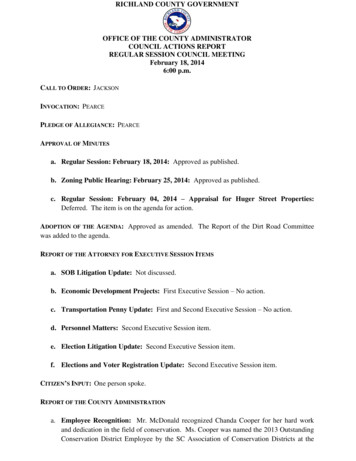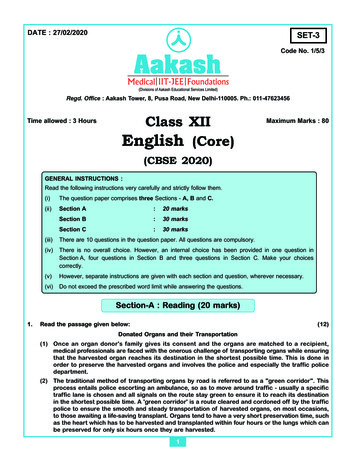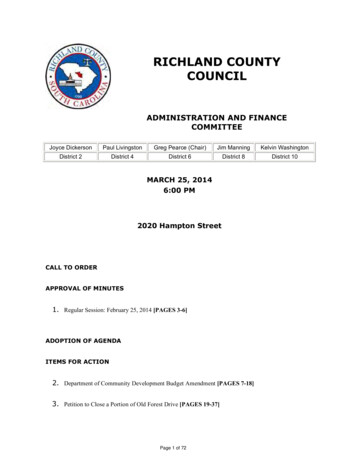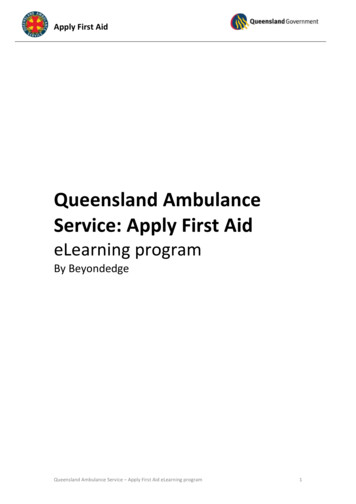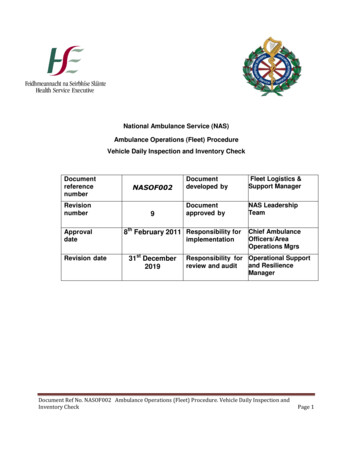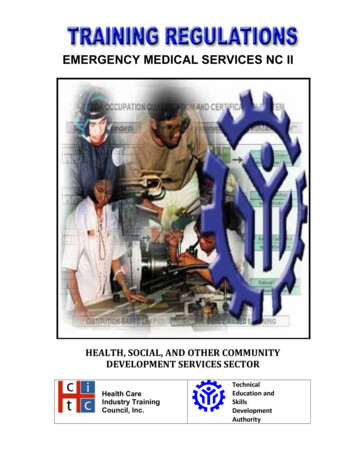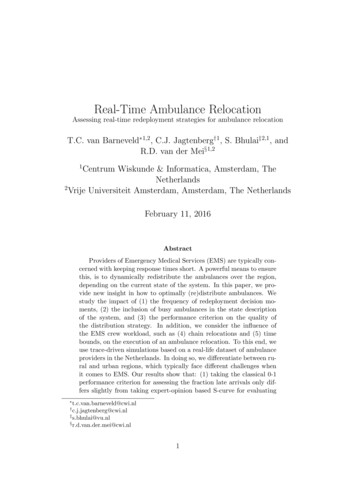
Transcription
Real-Time Ambulance RelocationAssessing real-time redeployment strategies for ambulance relocationT.C. van Barneveld 1,2 , C.J. Jagtenberg†1 , S. Bhulai‡2,1 , andR.D. van der Mei§1,21Centrum Wiskunde & Informatica, Amsterdam, TheNetherlands2Vrije Universiteit Amsterdam, Amsterdam, The NetherlandsFebruary 11, 2016AbstractProviders of Emergency Medical Services (EMS) are typically concerned with keeping response times short. A powerful means to ensurethis, is to dynamically redistribute the ambulances over the region,depending on the current state of the system. In this paper, we provide new insight in how to optimally (re)distribute ambulances. Westudy the impact of (1) the frequency of redeployment decision moments, (2) the inclusion of busy ambulances in the state descriptionof the system, and (3) the performance criterion on the quality ofthe distribution strategy. In addition, we consider the influence ofthe EMS crew workload, such as (4) chain relocations and (5) timebounds, on the execution of an ambulance relocation. To this end, weuse trace-driven simulations based on a real-life dataset of ambulanceproviders in the Netherlands. In doing so, we differentiate between rural and urban regions, which typically face different challenges whenit comes to EMS. Our results show that: (1) taking the classical 0-1performance criterion for assessing the fraction late arrivals only differs slightly from taking expert-opinion based S-curve for evaluating bhulai@vu.nl§r.d.van.der.mei@cwi.nl†1
the performance as a function of the response time, (2) adding morerelocation decision moments is highly beneficial, particularly for ruralareas, (3) considering ambulances involved in dropping off patientsavailable for newly coming incidents only slightly reduces relocationtimes, and (4) simulation experiments for assessing move-up policiesare highly favorable to simple mathematical models because of theinherent complexity and stochasticity.Keywords— Ambulance redeployment; Response times; Workload; Simulation1IntroductionIn emergency situations, ambulance providers need to respond to requests forambulances to provide medical aid and transportation to a hospital quickly.It is of utmost importance that ambulances are on-site at emergency locationswithin a short period of time. Therefore, it is crucial to position ambulancesthroughout the region such that they occupy good locations with respectto expected demand. Moreover, it is important that a good distributionof vehicles is maintained when ambulances become busy. Hence, modernambulance providers tend to relocate idle ambulances in order to achieveshort response times: the time between the emergency call and the arrival ofthe ambulance at the emergency scene.A commonly used quality measure for the performance of the ambulance service provider is the fraction of highest-urgency requests respondedto within a certain time standard, usually between 8 and 15 minutes. Related to this time threshold is the concept of coverage. An area is said to becovered if it is reachable by an ambulance within the time threshold. Onemay interpret this coverage as the ‘preparedness’ of the system to respond tofuture calls, and therefore one may solve the ambulance relocation problemby relocating ambulances in such a way that an acceptable coverage level ofthe region is ensured.1.1Related WorkThe literature on the ambulance relocation problem can roughly be dividedin two categories: periodic redeployment and real-time ambulance relocation.The authors of [4] provide a comprehensive survey on both types of repositioning. In the first category, redeployment of ambulances is considered preplanned to anticipate time-dependent fluctuations in demand, travel times,and number of ambulances on duty. These models, extensively surveyed in [5]2
and more recently in [16], effectively divide the planning horizon into discretetime periods, and then solve the static ambulance location problem1 multiple times. An early model in the literature on preplanned redeployment isproposed in [21]. In that paper, the authors extend the maximum expectedcoverage location problem (MEXCLP), proposed by [8], to a location modelwith time-dependent variation in travel times and fleet size, hence its nameTIMEXCLP. This model was applied to the EMS system of Louisville, Kentucky, and a decrease of 36% in response time was achieved. In [23], the focusis on preplanned repositioning as well, taking into account time-dependenttravel times by extending the single-period double standard model proposedin [11] into a multi-period version. Minimization of the number of ambulancerelocations over the planning horizon while maintaining a satisfactory coverage level, is the topic of [19], and a two-stage optimization model is proposed.Other papers in which periodic redeployment is considered include [9], [20],and [28].In this paper, we focus on real-time ambulance relocation. In contrast topreplanned repositioning, real-time ambulance relocation bases its decisionson the actual state of the system as it is observed throughout the day. Thereal-time situation changes often, e.g., due to the arrival of a request whereupon an ambulance is dispatched, or a service completion of a patient. Theseevents can trigger one or multiple ambulance relocations. Methods solvingthe real-time ambulance relocation problem, also known as ‘move-up’, canbe divided in two categories: offline and online methods. A comprehensivestudy on both types of methods is conducted in [29].In the offline approach, solutions to the ambulance relocation problemare precomputed for a variety of scenarios that may arise. Whenever such ascenario occurs in real time, the corresponding relocation is looked up andapplied. The level of detail of these scenarios may differ. For instance, socalled compliance table policies base their decisions on the number of idleambulances solely, and are therefore a category of policies with low detailabout the state of the system. Compliance tables are simple to understandand to use by dispatchers, making this kind of policy a commonly used one.In [13], the maximum expected covering relocation problem (MECRP) forthe computation of compliance tables is proposed. In [17], it is stated thatcomputing compliance tables is just the first part of computing relocationdecisions. The second part involves the actual assignment of ambulances towaiting sites, and two offline methods minimizing the total relocation timeare proposed, based on compliance tables computed by MECRP. Such adecoupling is also present in [25], in which the MECRP model is extended1in which each vehicle always returns to its own home base.3
by addressing ambulance unavailability and general performance measuresare considered. However, in contrast to the work done in [17], an onlinemodel for the actual assignment of ambulances to waiting sites is considered.In [1] a two-dimensional Markov chain is proposed to analyze the systemperformance of compliance table policies. This Markov chain is used in [24]as well. In this work, the steady-state probabilities serve as input to aninteger program for the computation of nested compliance tables.More sophisticated offline policies include additional information aboutambulances and requests in the scenarios, (e.g., [18] and [22]). However,scalability issues arise when the number of scenarios is too large, yielding anintractable solution space. To overcome this problem, both papers presentan approximate dynamic programming approach for the computation of ambulance relocation strategies.In offline methods, the computation time is not an issue as the solutionis computed beforehand. In contrast, in the online approach being able tocalculate a relocation decision in real time is of utmost importance. Sinceobtaining a relocation suggestion quickly is desirable, the main focus in literature on the online approach is on fast heuristics. One of the first ambulancerelocation methods is proposed in [12]. This model is based on the doublestandard model of [11] and it is solved via tabu-search. A dynamic relocation model called DYNAROC is presented in [2]. This article proposesa policy that includes both the ambulance dispatch as well as relocatingidle ambulances, and uses a fast tree-search heuristic to solve DYNAROC.A one-step look-ahead heuristic is the considered in [26]. Several scenarios are constructed that may occur one time-step later and these scenariosare combined with each possible relocation decision to obtain a classificationof these possible decisions. Finally, the online relocation models proposedin [14] and [27] are of the most importance to this work. These two methodsare summarized in Section 3.1.2ContributionThis paper aims to thoroughly analyze the dynamic ambulance relocationprocess, also known as ‘move-up’, from a practical point of view. In somesense, it could be considered as a search for the ‘best of both worlds’ combination of [14] and [27]. The two methods proposed in these papers areeasy to understand and to implement, and are therefore very suitable candidates to conduct further research on. Furthermore, unlike many other4
move-up policies, these two methods have recently been tested2 in practice.This combination of properties makes these paper a natural choice for ourinvestigation.Both methods have their strengths and shortcomings. A strength of theapproach described in [14] is the ability to anticipate multiple emergencyrequests rather than just the first one, as done in [27]. However, in [27] ageneral performance measure, modelled by an expert-opinion based functionof the response time, is considered, while the authors of [14] only use coverage as their performance measure. In Section 3.2 we discuss the differencesbetween both approaches.In this paper, we combine the methods developed in [14] and [27] toobtain practical insights on how an ambulance provider should implement amove-up strategy. We explore features of both algorithms, and their effectson various measures of the response time distribution. While our primaryfocus is on minimizing the fraction of late arrivals, other values – such as theaverage response time – are also reported.Note that decision makers in practice may come to different conclusionsbased on the characteristics of their EMS region. For example, the sizeof the demand – as well as how it is spatially distributed, distances andoverall workload have a great effect on the dynamics in the EMS system.These characteristics may affect the performance of a move-up policy, and apolicy that performs well in one region, does not necessarily give the sameresult elsewhere. Since we aim to construct a robust algorithm with respectto region characteristics, we include case studies for two different types ofregions: the rural region of Flevoland, and the urban region of Amsterdam,both in the Netherlands.Although ambulance move-up methods can offer great performance improvements, the well-known downside is that the workload for the crew increases, combined with additional costs for the travelled distances. Thereto,we analyze the trade off between the number of move-ups, the total traveltime needed for relocations, and the reduction in response times. Furthermore, we investigate whether move-up methods can benefit from taking intoaccount vehicles that are currently dropping of a patient at a hospital. Itis clear that these vehicles will become idle in the near future, but it is nottrivial how one should model this, nor is it evident that this will have a positive effect on the performance. We show that taking ambulances at hospitalsinto account has hardly any effect on the response times, but it does slightlydiminish relocation times – and thereby workload – for the crew.2This resulted in very good performance on patient-related performance indicators suchas the fraction of late arrivals and mean response times.5
We also investigate the effect of long-distance relocations. The furtherwe send an ambulance to, the longer it takes for the system to reach thedesired configuration. Thereto, we analyze two options: 1) we bound therelocation time to a certain maximum, i.e., ignoring options that would taketoo long, and 2) introduce a ‘chain movement’ of multiple vehicles, therebybreaking up the long drive into several smaller ones, that may be executedsimultaneously.All our results are obtained from trace-driven simulations, that we consider to be an accurate representation of reality.2Problem DescriptionIn this section we describe the general EMS process. When idle, ambulancecrews spend their shift at designated waiting sites. These could be basestations: structures set aside for parking idle ambulances with a crew roomand other facilities for the ambulance personnel. However, if the situationrequires, the ambulance crew may also be asked to park up at other waitingsites away from the base station, e.g., parking lots, fuel stations or otherhot spots. This practice tends to become more and more common in NorthAmerica, and although our models allow for this situation, we focus ourevaluation on the emergency system in The Netherlands where the numberof ambulances on duty usually exceeds the number of waiting sites. Hence,multiple ambulances are typically present at a waiting site.At a certain moment in time, a request for an ambulance arrives at theemergency control center. This call is answered by a dispatcher who assiststhe caller in first aid, inquires the condition of the patient and determines theurgency based on the answers. Meanwhile, the dispatcher consults the dispatching system which ambulance is most suitable to respond to the patient,taking into account the current location and status of the ambulances. Forcalls of the highest urgency, usually the closest idle ambulance is assigned toperform this task.After selecting an appropriate ambulance, the dispatcher informs the ambulance cre
1Centrum Wiskunde & Informatica, Amsterdam, The Netherlands 2Vrije Universiteit Amsterdam, Amsterdam, The Netherlands February 11, 2016 Abstract Providers of Emergency Medical Services (EMS) are typically con-cerned with keeping response times short. A powerful means to ensure this, is to dynamically redistribute the ambulances over the region, depending on the current state of the
